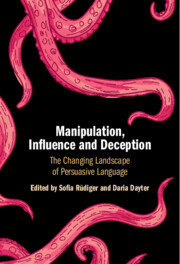Book contents
- Manipulation, Influence and Deception
- Manipulation, Influence and Deception
- Copyright page
- Contents
- Figures
- Tables
- Contributors
- I (Re)framing Persuasion
- II Persuasion and (New) Contexts of Use
- 3 Preference Organisation and Turn Design as Interactional Resources for Persuasion in Telesales
- 4 Persuasive Politics
- 5 A Cross-Context Examination of Online Comments’ Perceived Persuasion Power
- 6 A Terrible Experience!!! vs. A Terrible Experience
- 7 Influencing People Around the Globe
- III The Dark Side of Persuasion
- IV Persuasion and Algorithms
- V Discussion
- Index
- References
3 - Preference Organisation and Turn Design as Interactional Resources for Persuasion in Telesales
from II - Persuasion and (New) Contexts of Use
Published online by Cambridge University Press: 10 June 2025
- Manipulation, Influence and Deception
- Manipulation, Influence and Deception
- Copyright page
- Contents
- Figures
- Tables
- Contributors
- I (Re)framing Persuasion
- II Persuasion and (New) Contexts of Use
- 3 Preference Organisation and Turn Design as Interactional Resources for Persuasion in Telesales
- 4 Persuasive Politics
- 5 A Cross-Context Examination of Online Comments’ Perceived Persuasion Power
- 6 A Terrible Experience!!! vs. A Terrible Experience
- 7 Influencing People Around the Globe
- III The Dark Side of Persuasion
- IV Persuasion and Algorithms
- V Discussion
- Index
- References
Summary
Traditionally, the role of language in persuasion has been mostly studied in experimental settings with a focus on how persuasive messages are understood, processed, and ultimately complied with. Recently, a new approach has emerged that focuses on the sequential properties of language-in-use mobilised in real-life persuasion-in-interaction (Humă, 2023). This body of research illuminates how aspects of sequence organisation (Humă et al., 2019, 2020), turn design (Llewellyn, 2015), and lexical choice (Sikveland & Stokoe, 2016, 2020) are implicated in persuasion. The present study contributes to this line of work by zooming in on two configurations for formatting requests in sales interactions: when-formulated and if-formulated sales requests. Using conversation analysis to examine a corpus of 159 real-life telephone calls between salespeople and prospective customers, I show that the former configuration is more effective in eliciting productive responses that advance the commercial activity. These findings can be explained in terms of the differential opportunities afforded by the two configurations to reject the sales requests. Thus, this study strengthens the claim that, in real-life social interaction, persuasion is mainly realised through the architecture of possibilities for responsive action and not through the effects of language-in-use on individual minds.
Keywords
Information
- Type
- Chapter
- Information
- Manipulation, Influence and DeceptionThe Changing Landscape of Persuasive Language, pp. 45 - 62Publisher: Cambridge University PressPrint publication year: 2025
References
Accessibility standard: Inaccessible, or known limited accessibility
Why this information is here
This section outlines the accessibility features of this content - including support for screen readers, full keyboard navigation and high-contrast display options. This may not be relevant for you.Accessibility Information
Content Navigation
Allows you to navigate directly to chapters, sections, or non‐text items through a linked table of contents, reducing the need for extensive scrolling.
Provides an interactive index, letting you go straight to where a term or subject appears in the text without manual searching.
Reading Order & Textual Equivalents
You will encounter all content (including footnotes, captions, etc.) in a clear, sequential flow, making it easier to follow with assistive tools like screen readers.
Visual Accessibility
You will still understand key ideas or prompts without relying solely on colour, which is especially helpful if you have colour vision deficiencies.
You benefit from high‐contrast text, which improves legibility if you have low vision or if you are reading in less‐than‐ideal lighting conditions.
